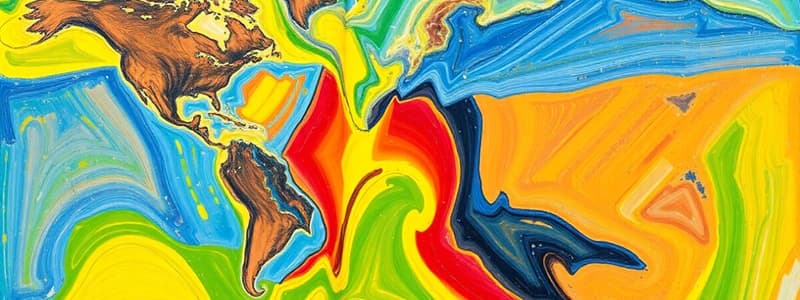Podcast
Questions and Answers
The Pacific Ring of Fire is characterized by frequent earthquakes and volcanic eruptions. Which geological feature primarily contributes to this activity?
The Pacific Ring of Fire is characterized by frequent earthquakes and volcanic eruptions. Which geological feature primarily contributes to this activity?
- A convergent boundary with subduction zones (correct)
- A transform fault where plates slide horizontally past each other
- A divergent boundary where tectonic plates move apart
- A concentrated zone of deep-sea trenches
The Pacific Ring of Fire is known for its seismic activity. What is NOT a direct consequence?
The Pacific Ring of Fire is known for its seismic activity. What is NOT a direct consequence?
- Formation of rift valleys. (correct)
- Frequent volcanic eruptions.
- Earthquakes of varying magnitudes.
- Tsunamis originating in the Pacific Ocean.
The Pacific Ring of Fire is highly susceptible to earthquakes and volcanic activity. What geological process is the primary driver of this?
The Pacific Ring of Fire is highly susceptible to earthquakes and volcanic activity. What geological process is the primary driver of this?
- Erosion from ocean currents
- The Earth's rotation
- The movement of tectonic plates (correct)
- Atmospheric pressure variations
In a region experiencing tension, which type of fault is most likely to occur?
In a region experiencing tension, which type of fault is most likely to occur?
A city is located in an area known for frequent seismic activity. What inference can a geologist accurately make about its proximity to tectonic features?
A city is located in an area known for frequent seismic activity. What inference can a geologist accurately make about its proximity to tectonic features?
Several factors contribute to the occurrence of earthquakes. Besides movement along faults, what other significant factor can directly trigger an earthquake in specific geological settings?
Several factors contribute to the occurrence of earthquakes. Besides movement along faults, what other significant factor can directly trigger an earthquake in specific geological settings?
Movement along a fault line generates seismic waves. How is the energy that produces these waves primarily stored before being released?
Movement along a fault line generates seismic waves. How is the energy that produces these waves primarily stored before being released?
An earthquake is recorded along a specific fault line. How does this event relate to the pre-existing stress conditions in the Earth's crust in that area?
An earthquake is recorded along a specific fault line. How does this event relate to the pre-existing stress conditions in the Earth's crust in that area?
During an earthquake, what makes a sturdy table a safer location compared to other places in a building?
During an earthquake, what makes a sturdy table a safer location compared to other places in a building?
During an earthquake, if a sturdy table is unavailable, what is the recommended course of action to ensure safety?
During an earthquake, if a sturdy table is unavailable, what is the recommended course of action to ensure safety?
Flashcards
Pacific Ring of Fire
Pacific Ring of Fire
A region around the Pacific Ocean known for frequent earthquakes and volcanic activity.
Why is the Pacific Ring of Fire active?
Why is the Pacific Ring of Fire active?
The Pacific Ring of Fire is prone to earthquakes and volcanic activity because it contains many tectonic plate boundaries.
Normal vs. Reverse Faults
Normal vs. Reverse Faults
Normal faults occur due to tension, while reverse faults occur due to compression.
Frequent Seismic Activity
Frequent Seismic Activity
Signup and view all the flashcards
Cause of Earthquakes
Cause of Earthquakes
Signup and view all the flashcards
Seismic Wave Generation
Seismic Wave Generation
Signup and view all the flashcards
Fault lines and earthquakes
Fault lines and earthquakes
Signup and view all the flashcards
Where to go during earthquake
Where to go during earthquake
Signup and view all the flashcards
Study Notes
- The Pacific Ring of Fire is known for frequent volcanic eruptions and earthquakes.
- The Pacific Ring of Fire is a region around the Pacific Ocean known for frequent earthquakes and volcanic activity.
- The Pacific Ring of Fire is prone to earthquakes and volcanic activity because it contains many tectonic plate boundaries.
- Normal faults occur due to tension, while reverse faults occur due to compression.
- A city that experiences frequent seismic activities is likely located near a tectonic plate boundary.
- Earthquakes are caused by movement along faults due to tectonic forces.
- Movement along a fault generates seismic waves by releasing stored energy from built-up stress in rocks.
- A strong earthquake recorded along a fault line indicates that stress was suddenly released, causing seismic waves.
- During an earthquake, a safe location is under a sturdy table.
- If no sturdy table is available during an earthquake, drop, cover, and stay away from windows or other hazards.
Studying That Suits You
Use AI to generate personalized quizzes and flashcards to suit your learning preferences.



